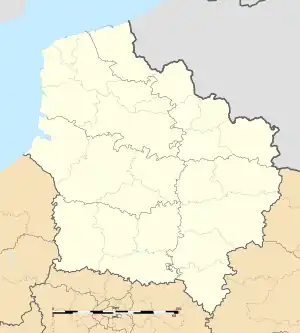Annequin | |
|---|---|
 The church of Annequin | |
 Coat of arms | |
Location of Annequin | |
 Annequin  Annequin | |
| Coordinates: 50°30′28″N 2°43′33″E / 50.5078°N 2.7258°E | |
| Country | France |
| Region | Hauts-de-France |
| Department | Pas-de-Calais |
| Arrondissement | Béthune |
| Canton | Douvrin |
| Intercommunality | CA Béthune-Bruay, Artois-Lys Romane |
| Government | |
| • Mayor (2020–2026) | Yves Dupont[1] |
| Area 1 | 3.99 km2 (1.54 sq mi) |
| Population | 2,145 |
| • Density | 540/km2 (1,400/sq mi) |
| Time zone | UTC+01:00 (CET) |
| • Summer (DST) | UTC+02:00 (CEST) |
| INSEE/Postal code | 62034 /62149 |
| Elevation | 19–38 m (62–125 ft) (avg. 23 m or 75 ft) |
| 1 French Land Register data, which excludes lakes, ponds, glaciers > 1 km2 (0.386 sq mi or 247 acres) and river estuaries. | |
Annequin (French pronunciation: [ankɛ̃]) is a commune in the Pas-de-Calais department in the Hauts-de-France region of France.[3]
Geography
Annequin is a large farming (and ex-mining) village situated some 4 miles (6.4 km) east of Béthune and 22 miles (35 km) southwest of Lille, at the junction of the D61 and the N41 roads.
Coal mining
Excavation of Mine 9 by the Compagnie des mines de Béthune began at Annequin in 1893. Mine 9 began production in 1896, ventilated by shaft 4bis. Shaft 12 was started at Annequin in February 1909 and reached a depth of 520 metres (1,710 ft). It was connected to Mine 9 and was used only for ventilation. Mine 9 was closed in 1964 and Shaft 12 in 1965.[4]
Population
| Year | Pop. | ±% p.a. |
|---|---|---|
| 1968 | 2,101 | — |
| 1975 | 1,897 | −1.45% |
| 1982 | 1,912 | +0.11% |
| 1990 | 2,086 | +1.09% |
| 1999 | 2,157 | +0.37% |
| 2007 | 2,331 | +0.97% |
| 2012 | 2,413 | +0.69% |
| 2017 | 2,201 | −1.82% |
| Source: INSEE[5] | ||
Sights
- The church of St. Martin, dating from the twentieth century.
- Remains of a 13th-century castle, destroyed in 1820.
- The war memorial.
See also
References
- ↑ "Répertoire national des élus: les maires". data.gouv.fr, Plateforme ouverte des données publiques françaises (in French). 2 December 2020.
- ↑ "Populations légales 2021". The National Institute of Statistics and Economic Studies. 28 December 2023.
- ↑ INSEE commune file
- ↑
- Compagnie de Béthune (in French), Association MINING, archived from the original on 31 July 2017, retrieved 31 July 2017
- ↑ Population en historique depuis 1968, INSEE
External links
Wikimedia Commons has media related to Annequin (Pas-de-Calais).
This article is issued from Wikipedia. The text is licensed under Creative Commons - Attribution - Sharealike. Additional terms may apply for the media files.